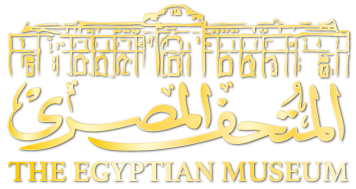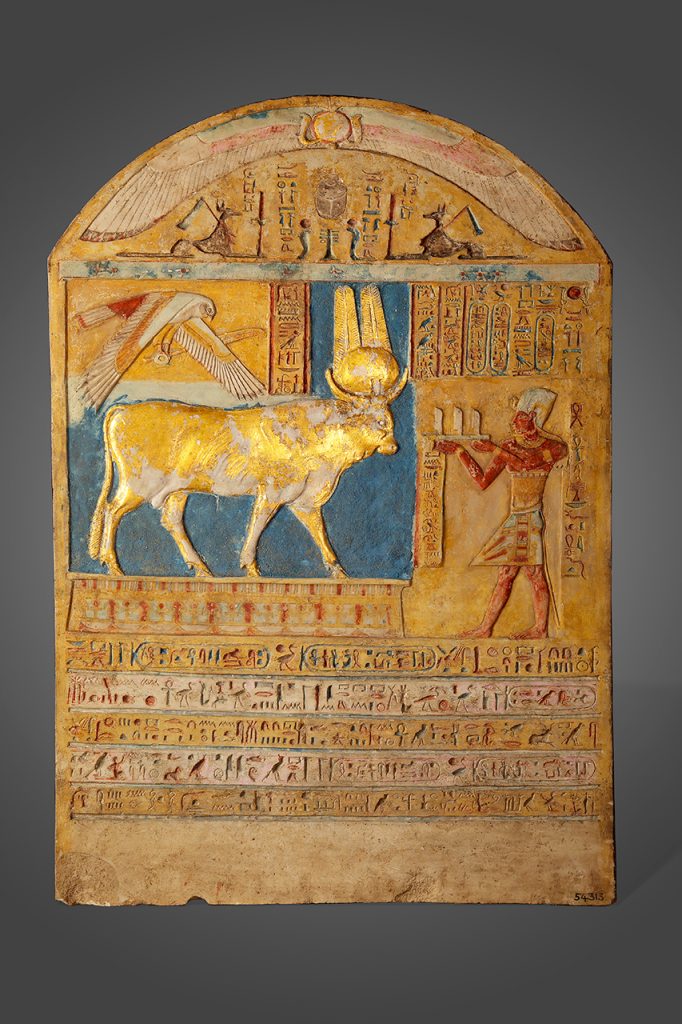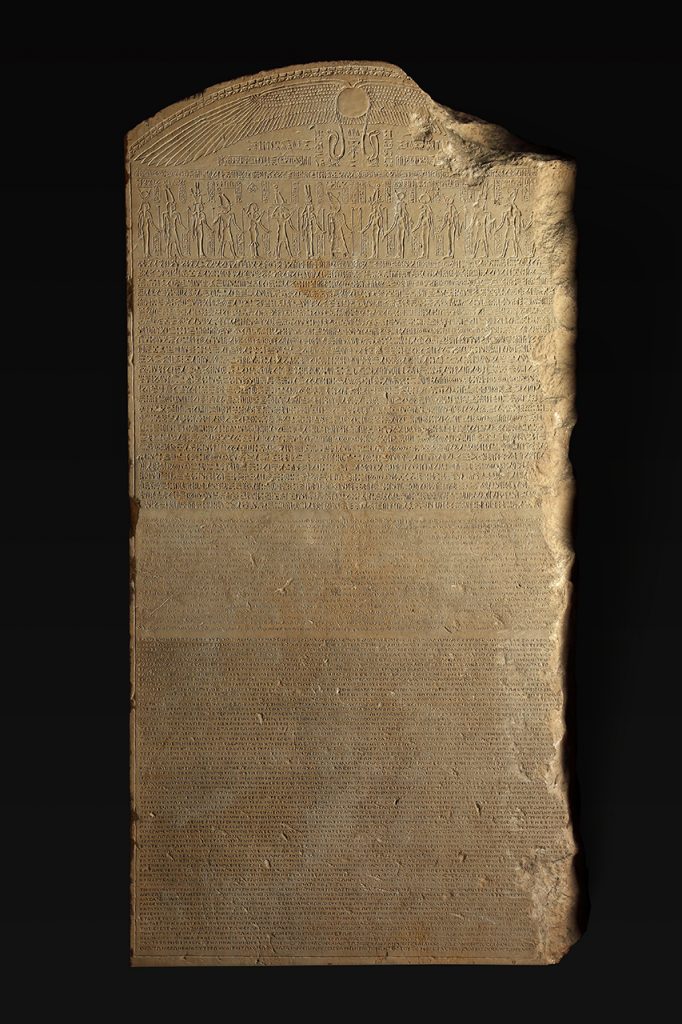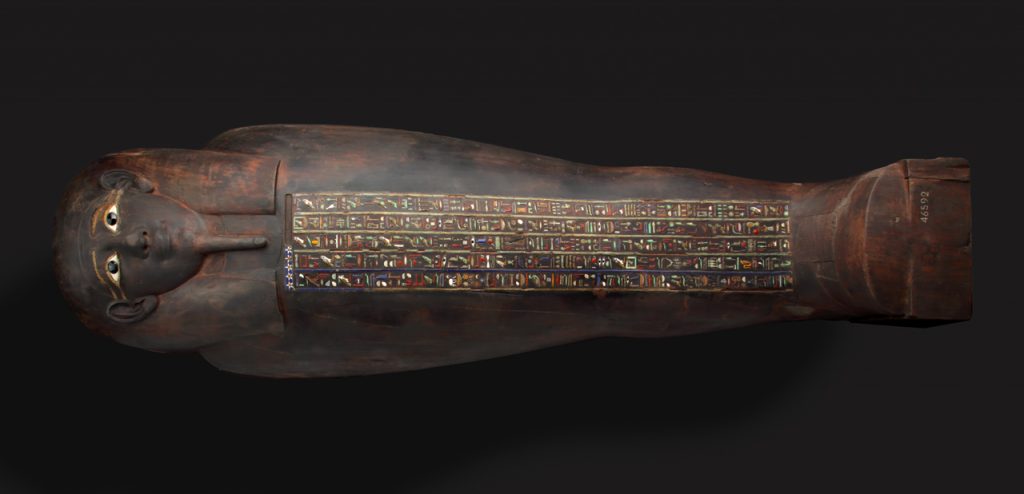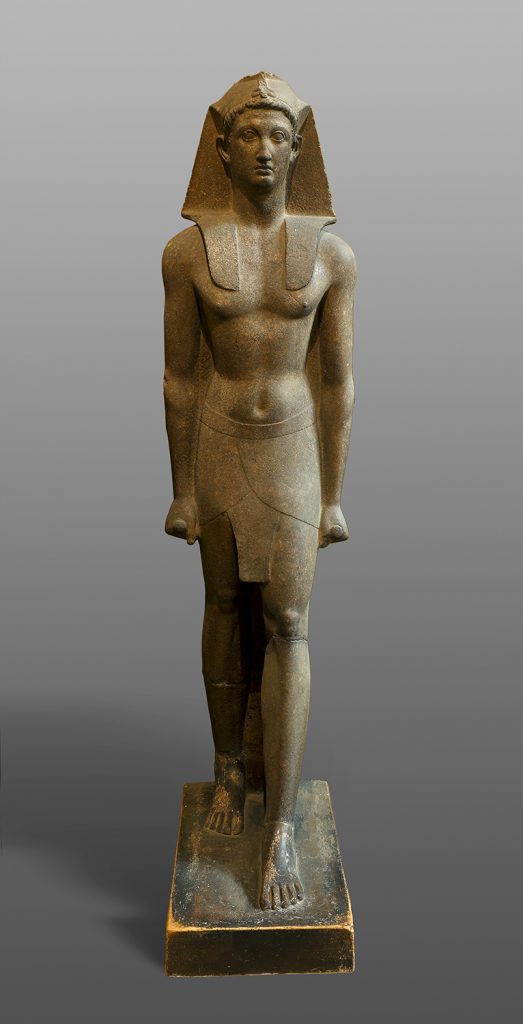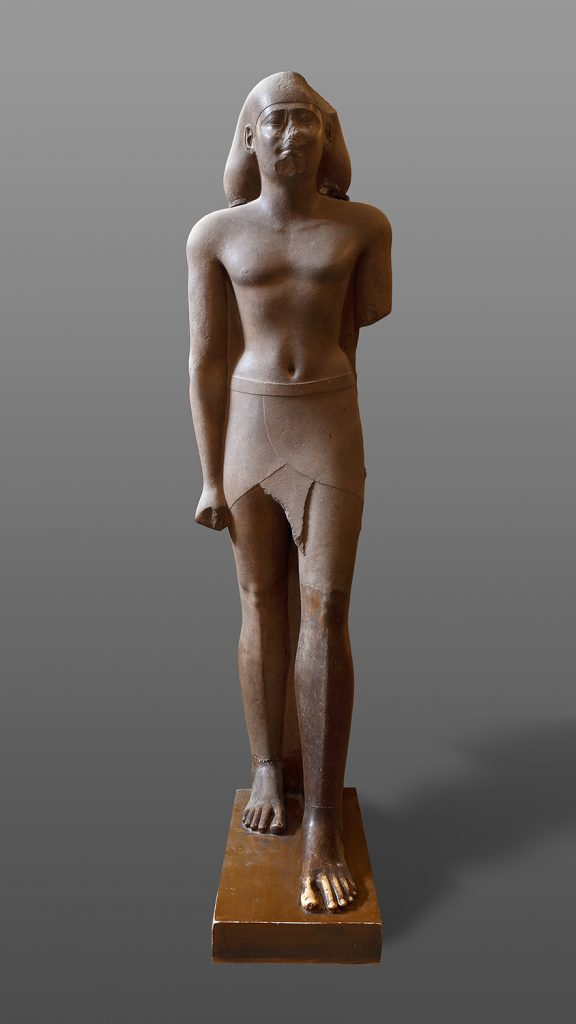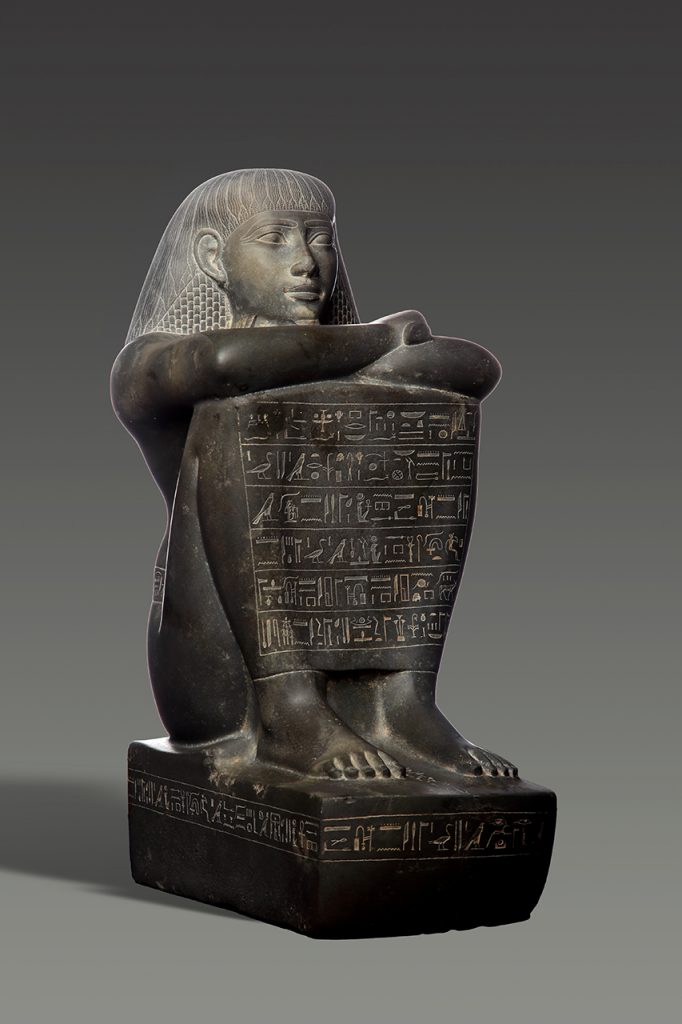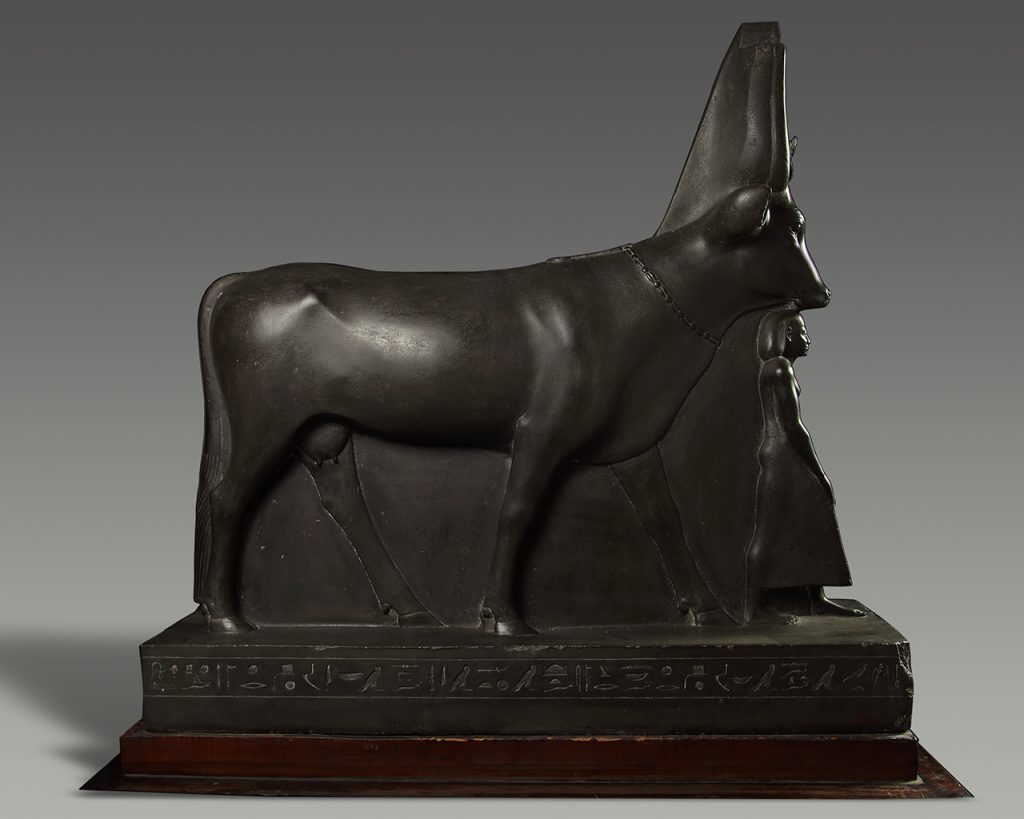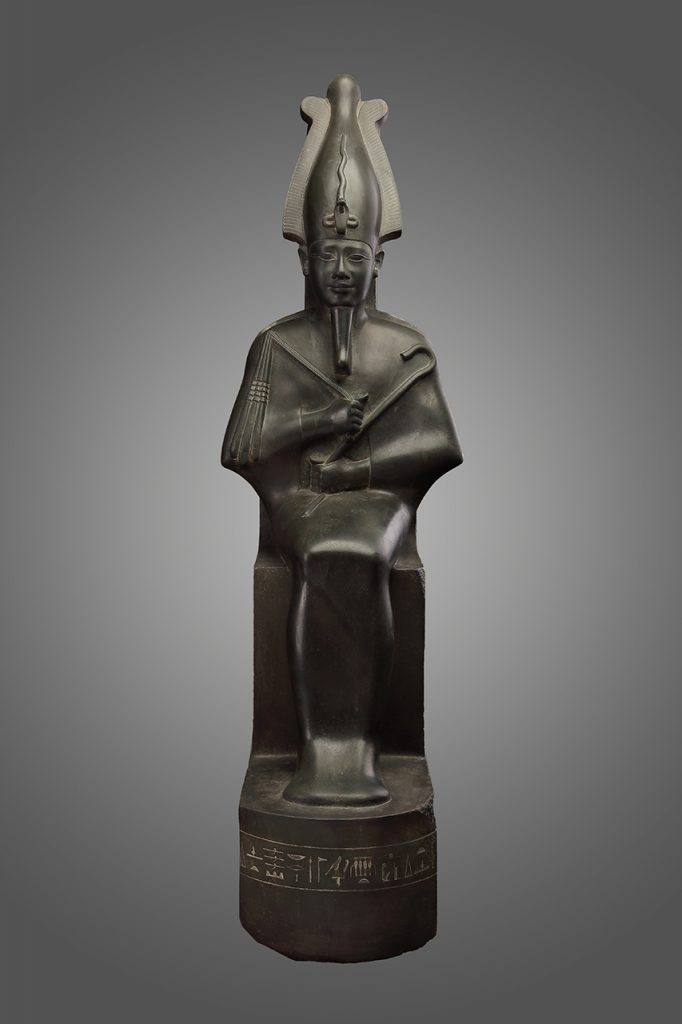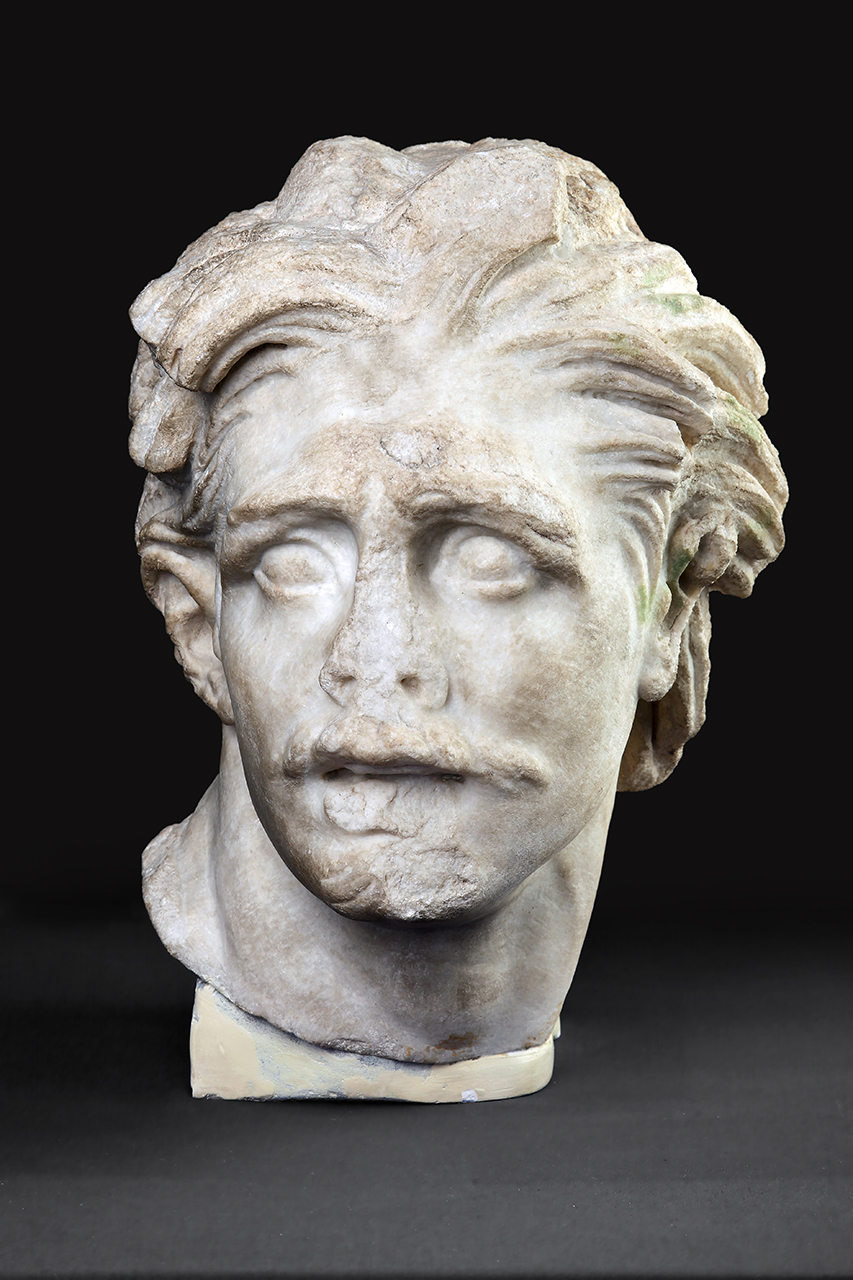

Head of a Gaul
Head of a Gaul
Artefact Details
Gallery number: 34 – Ground Floor
Period: Roman Period (c. 30 BC– AD 306)
Place of discovery: Unknown
Size: H 37.50 cm
Material: Marble
Gauls inhabited in the region of ancient Roman Empire, specifically the territory corresponding to modern France, Belgium, southern Netherlands, Switzerland, northern Italy and Germany to the west of the Rhine River.
The Gaul is characterised by his facial features, his stiff hair and his moustache. This head is considered one of the most impressive pieces of art of its era. Although much of the head is broken off, it is still easy to recognise the warrior’s sense of pain conveyed through the contracted eyebrows, turned head and dishevelled hair.
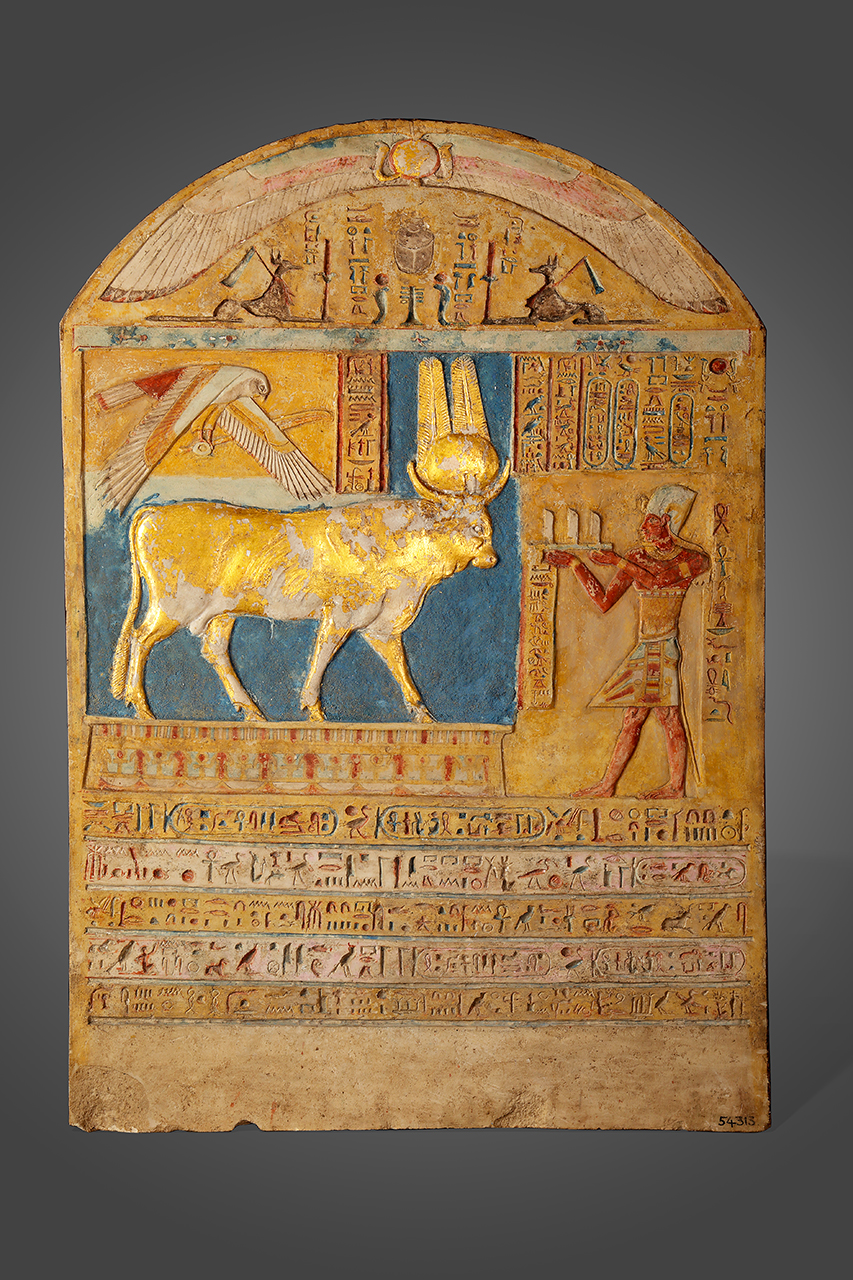

Buchis Bull Stela of Ptolemy V
Buchis Bull Stela of Ptolemy V
Artefact Details
Gallery number: 34 – Ground Floor
Period: Ptolemaic Period, reign of Ptolemy V Epiphanes (c. 204–180 BC)
Place of discovery: Southern Upper Egypt, Armant, Bucheum
Size: H 73.00 cm W 50.00 cm D/L 16.00 cm
Material: Limestone, gold, pigment (unspecified)
Dedicated by Ptolemy V to the god Buchis, the sacred bull who identified with the war god Montu that was worshipped at Armant, this round-topped stela was discovered in the underground necropolis known as Bucheum, which was devoted to the burials of Buchis’s earthly embodiments. Stelae such as this one was discovered in their thousands and were marked for each burial in the Bucheum.
Buchis was first mentioned in Egyptian religion during the 30th Dynasty in the reign of Nectanebo II. He was represented as a white bull with a black face, but according to the classical author Macrobius, his colour changed each hour of the day.
This stela is protected at the top by a winged sun-disk, representing Horus of Edfu, under which a scarab and a djed pillar (the symbol of the god Osiris) is flanked by two uraei and two crouching jackals. The body of the stela is separated from the upper register by the hieroglyphic symbol of the sky. The second register depicts Ptolemy V seen in an Egyptian king’s robes, offering the hieroglyphic sign for fields to a statue of Buchis Bull, who is crowned with a sun-disk with two uraei and double feathers. The gilded statue is placed on a gilded base and protected by a hovering falcon, an allusion to the sky and sun gods Horus and Re, holding a fan and a shen-ring (symbol of infinity).
Five horizontal lines of hieroglyphic text in the third register provide details of the dedication of the stela, made by Ptolemy V and his consort, Cleopatra I, in the 25th year of his reign.


Stela of Canopus Decree in Honor of Ptolemy III
Trilingual Stela of Canopus Decree in Honor of Ptolemy III
Artefact Details
Gallery number: 49 – Ground Floor
Period: Ptolemaic Period, Ptolemy III Euergetes I (c. 246–221 BC)
Place of discovery: Kom el-Hisn (Imu; Momemphis), Temple of Sekhmet-Hathor
Size: H 204 cm – W 93 cm – L 70 cm
Material: Limestone
The Decree of Canopus is a trilingual inscription in Egyptian hieroglyphs, Demotic and Greek. It commemorates a great assembly of priests held at Canopus to honour Ptolemy III Euergetes, his wife Queen Berenice and Princess Berenice. It is the second earliest instance of a series of trilingual inscriptions, the most famous example of which is the Rosetta Stone.
This round-topped stela is decorated with a frieze of stars that runs around the top of the stela’s lunette. It depicts a winged sun-disk with pendant uraei and shen-ring (symbol of infinity) hanging from their bodies beside the names of Horus Behedet and the cartouches of the king and the queen. Below is a register containing sixteen divinities and kings facing to the centre (eight on each side), where the innermost figure on the proper right side is Ptolemy III. Beneath are one hundred and ten horizontal lines of inscription; the top twenty-six of which are in hieroglyphs; the second twenty are in the Demotic script, while the final sixty-four are in Greek. The inscription describes various subjects such as military campaigns, famine, governmental organisation and Egyptian religion in Ptolemaic Egypt. It mentions the king’s donations to the temples and his support for the Apis and Mnevis (Mer-wer) cults. It declares the deceased princess Berenike as a goddess and creates a cult for her. Finally, it orders the decree to be incised in stone or bronze in both hieroglyphs and Greek, and to be displayed in the temples.
This stela inaugurates the most accurate solar calendar known to the ancient world, with three hundred and sixty-five and quarter days per year. The upper-right corner of the stela is missing a piece, and the right edge of it is damaged.


Coffin of Petosiris
Anthropoid Coffin of Petosiris
Artefact Details
Gallery number: 50 – Ground Floor
Period: Ptolemaic Macedonian Period/Argead Dynasty (c. 332–305 BC)
Place of discovery: Middle Egypt, Tuna el-Gebel, Necropolis, Funerary House No. 21 Petosiris
Size: H 39.00 cm W 53.00 cm D/L 193.00 cm
Material: Pinus halepensis wood (conifers), glass
The tomb of Petosiris, the High Priest of god Thot in Hermopolis, is a unique example of this era. It has the appearance of a small temple from the Graeco-Roman period. The scenes from the tomb are a mixture of Egyptian, Greek and Persian influences and are of outstanding technical quality and rich symbolism.
The tomb holds the stone sarcophagus of Petosiris, in which two wooden anthropoid coffins were found. The innermost coffin depicts Petosiris wearing a divine beard and a long wig. The large eyes and bronze eyebrows that take the form of wedjat eyes, are inlaid with coloured glass. The body, wrapped in a mummiform garment, is decorated from chest to ankles with five vertical lines of inlayed hieroglyphic inscriptions, topped by a hieroglyphic sign of sky decorated with a band of stars, of which two-thirds is now missing. The hieroglyphic inscriptions and the band of stars are inlaid with glass coloured red, yellow, green, blue and white to imitate fine stones and precious materials. The inscriptions bear the name and the titles of Petosiris and the formula from Chapter 42 of the Book of the Dead, helping the deceased to overcome the difficulties of his journey towards the afterlife. The wood of the coffin shows some cracks and a small piece of the outer layer of wood is missing on the left side at the feet.


Statue of a Ptolemaic King
Statue of a Ptolemaic King
Artefact Details
Gallery number: 49 – Ground Floor
Period: Ptolemaic Macedonian Period/Argead Dynasty, reign of Alexander IV (c. 317–310 BC)
Place of discovery: Thebes East, Karnak Temple (Ipet-Isut)
Size: H 280.00 cm W 61.00 cm D/L 106.00 cm
Material: Red granite
The mixture of Hellenistic Greek and traditional Egyptian styles are well illustrated in this colossal statue of a Ptolemaic king. The sculpture of the body is beautifully rendered, with elegantly and simply modelled idealized elements typical of Egyptian art.
The nemes crown is sharply turned at the shoulders and set back on the forehead to display the curls across the forehead. The face of the king is modelled in Hellenistic style, but maintains an idealised approach to the portrait. The round eyes are heavily rimmed and the brows are simple and his Grecian nose is long, narrow and straight. The mouth is narrow but full and the median line of the mouth is visible on the bottom lip, and he has a prominently rounded chin. He is wearing the royal shendyt kilt and stands with his left leg is forward, arms by the sides holding the traditional enigmatic cylindrical objects. This statue remains unidentified due to the lack of inscriptions.


Colossal Statue of an Official Named Horemheb
Colossal Statue of an Official Named Horemheb
Artefact Details
Gallery number: 49 – Ground Floor
Period: Ptolemaic Period (c. 304-30 BC)
Place of discovery: Delta Western, Kom Geif (Naukratis; el-Nibeira; el-Niqrash), Great Mound
Size: H 360.00 cm
Material: Granite
Horemheb was an official who served under the first Ptolemies. He had control over the Greek colony of Naukratis, which was established in the 26th Dynasty on the Canopic branch of the Nile river as trading post for the Greeks in Egypt. Herodotus mentions that King Amasis gave Naukratis to Greek colonisers, but there is an evidence that it was already founded under King Psamtek I.
Although this statue dates to the Ptolemaic Period, its iconography and style is almost exclusively Egyptian. It depicts Horemheb with his left leg forward, arms by his sides, holding the traditional enigmatic cylindrical objects. His wig has rounded ends on the back of his shoulder, leaving his ears uncovered and he is wearing the shendyt kilt. The face is damaged, the left arm is missing, part of kilt is missing and the left leg and right foot restored.
The back pillar of the statue is inscribed with hieroglyphic inscriptions bearing his name, titles and prayers to gods Amun, Mut and Khonsu (the Theban Triad) together with god Min. The size of this statue is usually reserved for kings and gods, indicating that Horemheb was considered an elite.


Statue of Hor son of Ankh Khonsu
Statue of Hor son of Ankh Khonsu
Artefact Details
Gallery number: 25 – Ground Floor
Period: Third Intermediate Period
Dynasty: 25th dynasty (c. 712-653 BC)
Place of discovery: Thebes East, Karnak Temple (Ipet-Isut) Precinct of Amun, Court of the Cachette, Karnak Cachette.
Size: H. 51 cm
Material: Greywacke
This block statue is an example of a reintroduction of Middle Kingdom stylistic features, which is a characteristic element of the 25th Dynasty art. These statues depict their owners with their legs drawn tightly up against their chests and their arms folded on top of their knees. This block form would have protected them from damage since they were placed in temple gateways to ensure that the deceased would stay forever near the god and receive a part of the divine offerings and prayers. The head of the statue is projected from the body, probably to indicate the soul emerging from a mound in the underworld at the moment of rebirth.
This block statue depicts Hor, who was the son of Ankh-khonsu and a Prophet of Montu, and was dedicated to him by his grandson, also called Hor. His family was part of the Theban clergy for over five generations. It represents him seated on a low cushion with his legs drawn tightly up against his torso and his right forearm crossed over the left, where his hands hold rolls of cloth or papyri. He is wearing a beautifully engraved double wig, a long kilt and an inscribed belt. His face is thin with almond-shaped eyes, a hollow nose and big ears projecting from the double wig. The chin is supported and attached to the cubed body.
Six horizontal lines of hieroglyphic inscriptions are incised on his kilt together with one vertical line between his feet and one horizontal line goes around the base of the statue.


Statue of Psametik
Statue of Psametik Protected by goddess Hathor as a Cow
Artefact Details
Gallery number: 24- Ground Floor
Dynasty: 26th dynasty, reign of Ahmose II (Amasis) Khnumibre (c. 570-526 BC)
Place of discovery: Memphite Region, Saqqara North, Tomb of Psamtek
Size: H 97.00 cm W 29.00 cm D/L 103.00 cm
Material: Greywacke
This statue of goddess Hathor was discovered together with two other statues of goddess Isis JE 38929 and god Osiris JE 38928 in the tomb of Psamtek, a high official of the late 26th Dynasty, who bears many titles as the Overseer of the Seals and the Governor of the Palace. These three statues are superb examples of their era, specifically the reintroduction of Old Kingdom stylistic features such as the smooth and rounded surfaces that contrast with the very hard stone.
Hathor is normally depicted as a cow or a woman wearing horns or cow ears and was worshiped throughout Egypt from the early Predynastic period as a member of the divine triad of Dendera together with Horus-Behdety and their son Ihy. She was associated with joy, beauty, dance and life, and carried many titles including Mistress of Life and Lady of Stars. Hathor was associated with motherhood as well as gems and precious materials, especially turquoise and gold. As Mistress of Turquoise, she is associated with a number of turquoise mines in the Sinai that bear her name.
This sculpture of the deceased with the goddess Hathor, in the form of a cow, portrays similarities to New Kingdom royal statuary, and is no doubt inspired by the chapel from the Temple of Tuthmose III at Deir el-Bahri in Thebes JE 38574-5. The modelling of the goddess is elegant in its proportions with well-defined muscular features. Her horns are incorporated into her usual crown with sun-disk and uraeus, together with two feathers. She wears a necklace composed of numerous strings of small beads gathered at each end and threaded through two or larger circular beads with a menat counterweight on her back, an emblem sacred to Hathor. Psamtek, as a pendant of her necklace, emerges from under her protection, as indicated by her left foot forward. He wears a simple bag wig and a pendant, possibly a seal, of his own. His palms are placed on his long kilt, which is inscribed with his name and titles. In keeping with the style of the companion pieces, the offering prayer is inscribed around the base in hieroglyphics.


Statue of Osiris – god of the Afterlife
Statue of Osiris, god of the Afterlife
Artefact Details
Gallery number: 24 – Ground Floor
Period: Late Period
Dynasty: 26th Dynasty, reign of Ahmose II (Amasis) Khnumibre, (c. 570-526 BC)
Place of discovery: Memphite Region, Saqqara: North, Horemheb Area, Psamtek
Size: H 89.50 cm W 28.00 cm D/L 46.00 cm
Material: Greywacke
This statue of the god Osiris was found together with two companion statues of the goddesses Isis (JE 38929) and Hathor (JE 38927) in the tomb of Psamtek, a high official of the late 26th Dynasty, who bears many titles as the Overseer of the Seals and the Governor of the Palace. These three statues are superb examples of their era, specifically the reintroduction of Old Kingdom stylistic features such as the smooth and rounded surfaces that contrast with the very hard stone.
Osiris was the god of the deceased, master of the underworld, afterlife and lord of eternity. According to the Heliopolis Ennead, Osiris was the son of Geb and Nut, the god of the earth and the goddess of the sky respectively, and was one of at least four siblings. He was also the brother/husband of Isis, the goddess of motherhood, magic, fertility, healing and rebirth. His brother Seth was the god of war, chaos and storms; and his sister Nephthys, wife of Seth, assisted in funerary rites, working with her sister Isis in a protective role. In some versions of the mythology there is another brother, Horus the Elder (Horus the Great). Osiris was also the father of Horus (the younger).
According to Egyptian mythology, Osiris ruled Egypt, providing civilisation to his people through the knowledge of agriculture and the law. Seth was extremely jealous of his brother and killed him, dismembering and distributing the corpse throughout the many Nomes of Egypt. On the death of Osiris, Seth became king of Egypt with his sister/wife Nephthys. Isis mourned her husband, and with her great magical powers decided to find and bring him back to life. With the help of her sister Nephthys, Isis searched every Egyptian Nome, collecting the pieces of her husband’s corpse, reassembling and holding them together with linen wrappings. Isis breathed life back into his body to resurrected him and soon conceived their child Horus (the younger). Osiris then descended into the underworld, where he became its ruler.
This statue depicts Osiris sitting on a throne in a mummified form wearing a close-fitting enveloping garment, a divine beard attached to his chin, and the Atef crown flanked by two ostrich feathers, adorned with the uraeus cobra. He holds the royal crook and flail with his arms crossed on his chest. The base of the statue is inscribed with an offering prayer, while the back pillar of the statue is not inscribed.


